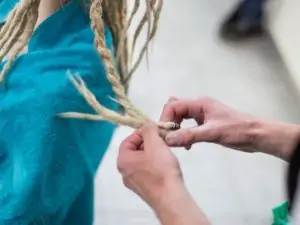From my experience, the first few weeks when you start growing dreadlocks at home are nerve-wracking.
Yes, I mean it.
You have to wear a headwrap if you've used wax and live through the soreness when you retwist your hair too tight. But, overlooking all that, there's the joy of seeing your hair turn into locs after continuous coiling and twisting.
So, to show you how to get dreads fast, we'll look at methods suitable for different hair types. Yes, even people with straight hair can learn how to do dreads.
How To Make Dreads in 5 Ways

1. Backcombing
You know the natural way of combing hair from your forehead to your nape. Now, to create knots, you can reverse the process and comb a strand of hair from the tip back to the root. I'll explain shortly.
Here's a step-by-step guide on how to make twist dreads by backcombing.
Step 1
Wash your hair. You want to start the matting process with hair that's residue-free. Therefore, wash it with a gentle shampoo and condition it. You can air dry it or blow it dry without using too much direct heat.
Step 2
Divide your hair with a rat tail comb to form sections that'll make the locs. The size of each section matters as it controls your loc size. For example, if you split your hair into squares of about half an inch, you can make over 100 locs.
Step 3
Hold one section and push its hair back toward the scalp using a rat tail comb. In essence, you're combing in the opposite direction, backcombing. Start close to the scalp as you move toward the tip of the section, backcombing with three-inch strokes.
Nonetheless, be gentle; avoid pulling your hair. Backcombing works for straight hair or chemically treated coarse hair. It's not the best choice for kinky or coarse natural hair and also for box braids.
2. Twist And Rip Method
No, you'll not rip your hair out of your scalp. Here's a simple guide on how to get dreadlocks using the twist and rip technique.
Step 1
Divide your hair into sections of about one inch, and hold them in place using rubber bands. These ensure the hair sections are of equal size to have uniform locs. Alternatively, spray your hair with tightening spray instead of holding it with rubber bands.
Step 2
Twist each hair section at a time in one direction. Start twisting from the root, and when you reach the center of each hair section, separate the hair randomly without using too much force. It'll be like you're ripping something apart but gently. Ripping prevents it from untwisting.
Step 3
Palm roll all the locs to shape them. You can also apply wax or best lock and twist gel to enhance matting.
For example, you can divide your hair into sections and tie rubber bands, as explained above. Next, wash it as you rub the hair sections so that the hair shafts connect.
Thirdly, remove the rubber bands, apply wax, and palm roll each hair section separately to tighten the knots.
3. Braiding Method

Like in the other methods, you'll start by washing your hair and sectioning it based on the locs size you want. Next,
- Tie the sections of hair with rubber bands so you can work on one part at a time.
- Remove a rubber band, braid the hair, and tie the tip of the hair with a rubber band to hold it in place. To braid, split one section of hair into three parts and braid them. It's simple; place one hair part over another in a sequence that forms a braid.
- Wax each braid and complete the technique by palm rolling it.
When you leave these braids on for several months, the hair knots into locs.
If you're wondering how to make dreads when you have long hair, this is the best method because you only need to know how to braid.
However, these locs take up the braid pattern, and they may be asymmetrical unless you split the three parts of each braid equally.
4. Finger Coil Method
It's my favorite method and the one that got me shoulder-length dreads. Well, I'm still growing them longer.
Here's how to do dreads using the finger coil method.
Step 1
Pull out a section of hair using an afro pick or rat tail comb. Start at the nape and work your way to your forehead. The sectioned hair should be the size of the dreadlocks you want.
Step 2
Spray water on the sectioned hair to dampen it for easy coiling. Proceed to oil the hair at the root with an essential oil or wax, and glide your fingers to the tips to spread the oil and moisten the whole strand.
Step 3
Twist or palm roll the hair so that it coils.
Step 4
Clip the hair at the root to maintain the coil. Repeat this process throughout, remove the hair clips, style the locs into a bun or other hairstyle and dry them.
However, when you retwist at least once a month, they turn into locs. It's the best method for short hair.
5. Wool Rubbing Technique
Well, I'd say this is the last option after you've tried everything else. Why? The friction from the wool may give you the frizz you're looking for, but it might not be as neat as twisting or coiling your hair for a matted look.
I know you're curious about what this technique involves, so I'll tell you. Just rub a woolen hat or sweater on your hair for about 15-20 minutes.
One, you'll have flyaways, yet you're looking for locs. Two, you may hurt your scalp as you separate the frizz into locs. So can we all agree this is not how to make dreads, especially for kinky hair? Yes?
Let's summarize our discussion by answering these popular questions below...
FAQs About How To Start Dreads
How Do You Make Your Dreads?
When you get used to twisting or coiling your dreadlocks, it becomes easier to do it at least once a month at home and save from spending on dreadlocks prices. We've looked at the best methods to grow dreads above, and you can choose one depending on your hair length and texture.
If you have kinky or coarse hair, then finger coiling will work fast. On the other hand, if you have straight hair, then you need a method that forces the hair to form mats as it lacks curly texture. For that reason, you can try the twist and rip technique or backcombing.
Here are quick tips for backcombing hair for dreads:
Do Dreadlocks Hurt The Scalp?
No, not really -- as long as you're gentle as you coil or twist your hair. Additionally, moisturize your scalp because when you loc your hair, you expose it to the sun, increasing the risk of a dry, irritated scalp.
On top of that, if you wax your locs, dry them as product build-up makes the hair heavy. Lastly, you can avoid hurting your scalp by reducing the number of times you retwist or style your locs.
Is There An Easy Dread Style?
Yes, the easiest methods to get matted hair are to neglect it until it knots or rub a woolen hat. The disadvantage is that you need to section your hair to define the locs size, so when you neglect your hair before you divide it into square sections, you'll have an unkempt mess.
Final Thoughts
You can loc short or long hair, but most people prefer to start with short hair as it's easier to twist and manage.
Dreadlocks take time to form. Therefore, repeat some of the steps regularly, such as palm rolling each hair section to hasten the matting process.
You can go the easy way and neglect your hair until it knots, but you'll not like the outcome. Instead, section your hair neatly, then twist, braid or finger coil it.




